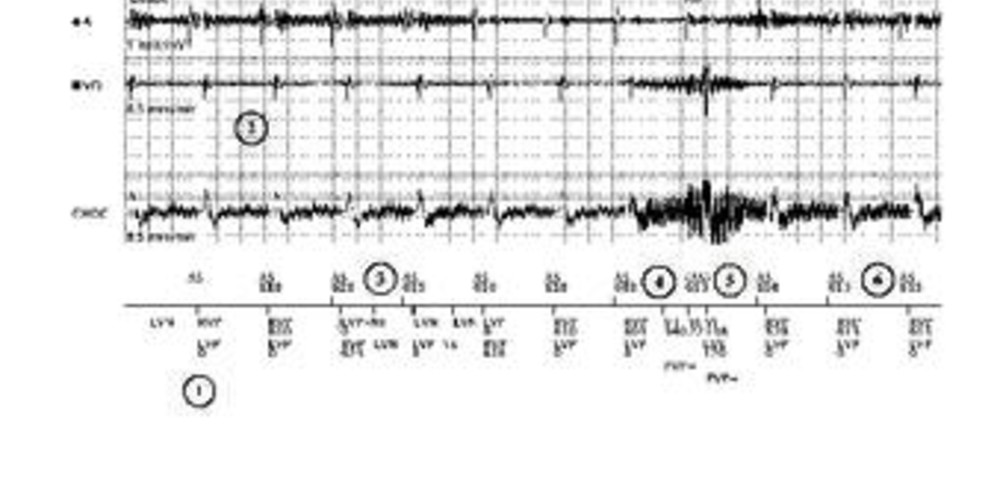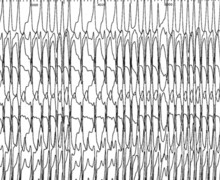50 Hertz oversensing
Tracing
Manufacturer Boston Scientific
Device ICD
Field Sensing
N° 1
Patient
This 59-year-old man underwent implantation of a Boston Science Cognis triple chamber defibrillator in the context of severe ischemic cardiomyopathy with left bundle branch block. An episode of NSVT is diagnosed during a routine follow-up visit.

Graph and trace
Summary
Episode diagnosed as NSVT.
Graph and tracing
- atrial sensing and biventricular stimulation;
- sensing of very rapid signals, which saturate the baseline in the atrial channel, and are also visible on the ventricular sensing channel and on the high-voltage channel, though of lower amplitude; these signals are not sensed;
- sensing of noise at the level of the LV channel (LVP-Ns);
- increase in the amplitude of these signals at the level of the RV sensing channel and of the high-voltage channel; temporary oversensing of the noise at the level of the RV sensing channel;
- after 3 consecutive short cycles (VT-VF-VF), an episode of NSVT is recorded;
- end of oversensing;
- further oversensing on the RV channel, though the initial 8 out of 10 sensing criterion is never fulfilled.
Second tracing
- same as previous tracing at a different sweep speed, highlighting the characteristic sinusoidal 50 Hz waveform (20 ms between signals).
Other articles that may be of interest to you







This tracing highlights the usual characteristics observed in patients presenting with electromagnetic interference, including
1) exposure to an emitting source at the time of the episode (in this patient a poorly insulated household appliance), and
2) short, regular, uninterrupted signals throughout the cardiac cycle. By changing the sweep speed, the Boston Scientific defibrillators enable the demonstration of a characteristic sinusoidal waveform with a 20-ms separation between each signal; in double or triple chamber defibrillators, the signals are usually visible on the atrial, the RV and LV and the high-voltage channels. Their amplitude is greater on the high-voltage than on the sensing channel. They are managed by a) identifying their source, and b) avoiding the use of poorly grounded devices.
A mode of response to noise can be programmed, which is activated when the noise is prolonged and diagnosed by the device. This algorithm is triggered by signals sensed in the noise window of the ventricular blanking period. The tracing displays the AN, VN, RVN or LVN noise markers, while the markers AP-Ns, VP-Ns, RVP-Ns and LVP-Ns indicate asynchronous pacing in response to the sensing of continuous noise. An asynchronous (AOO, VOO or DOO) or an inhibitory (OOO) pacing mode can also be programmed.